Progress of Mine Land Reclamation and Ecological Restoration Research Based on Bibliometric Analysis
Abstract
1. Introduction
2. Materials and Methods
3. Results and Analysis
3.1. Analysis of the Annual Scientific Production on LRER
3.2. Analysis of Literature Citations on LRER
3.2.1. Annual Citation Rate
3.2.2. Analysis of Highly Cited Articles
3.3. Main Countries/Regions Conducting Research on LRER
3.4. Main Institutions Conducting Research on LRER
3.5. Research Categories on LRER
3.6. Main Journals on LRER
3.7. Hot Research Topics and Trends on LRER
3.7.1. High-Frequency Keyword Analysis
3.7.2. Cluster Analysis (CA) and Multiple Correspondence Analysis (MCA) of High-Frequency Keywords
3.7.3. Thematic Evolution Analysis
4. Discussion
5. Conclusions
Author Contributions
Funding
Institutional Review Board Statement
Informed Consent Statement
Data Availability Statement
Conflicts of Interest
Abbreviations
| CA | Cluster analysis |
| LRER | Land reclamation and ecological restoration |
| MCA | Multiple correspondence analysis |
| MCP | Multiple-country publications |
| SCP | Single-country publications |
| SDGs | Sustainable Development Goals |
References
- PwC. Mine 2022: A Critical Transition. Available online: https://www.pwc.com/mine (accessed on 27 January 2023).
- Zhang, L.; Hu, Z.; Yang, D.; Li, H.; Liu, B.; Gao, H.; Cao, C.; Zhou, Y.; Li, J.; Li, S. Land Use Dynamic Evolution and Driving Factors of Typical Open-Pit Coal Mines in Inner Mongolia. Int. J. Environ. Res. Public Health 2022, 19, 9723. [Google Scholar] [CrossRef]
- Sonter, L.J.; Moran, C.J.; Barrett, D.J.; Soares, B.S. Processes of land use change in mining regions. J. Clean. Prod. 2014, 84, 494–501. [Google Scholar] [CrossRef]
- Liu, X.Y.; Bai, Z.K.; Zhou, W.; Cao, Y.G.; Zhang, G.J. Changes in soil properties in the soil profile after mining and reclamation in an opencast coal mine on the Loess Plateau, China. Ecol. Eng. 2017, 98, 228–239. [Google Scholar] [CrossRef]
- Wang, J.M.; Yang, R.X.; Bai, Z.K. Spatial variability and sampling optimization of soil organic carbon and total nitrogen for Minesoils of the Loess Plateau using geostatistics. Ecol. Eng. 2015, 82, 159–164. [Google Scholar] [CrossRef]
- Hu, Z.Q.; Xiao, W. Optimization of concurrent mining and reclamation plans for single coal seam: A case study in northern Anhui, China. Environ. Earth Sci 2013, 68, 1247–1254. [Google Scholar] [CrossRef]
- He, T.T.; Xiao, W.; Zhao, Y.L.; Deng, X.Y.; Hu, Z.Q. Identification of waterlogging in Eastern China induced by mining subsidence: A case study of Google Earth Engine time-series analysis applied to the Huainan coal field. Remote Sens. Environ. 2020, 242, 111742. [Google Scholar] [CrossRef]
- Liu, X.; Shi, H.; Bai, Z.; Zhou, W.; Liu, K.; Wang, M.; He, Y. Heavy metal concentrations of soils near the large opencast coal mine pits in China. Chemosphere 2020, 244, 125360. [Google Scholar] [CrossRef]
- United Nations. UN Sustainable Development Goals. Available online: https://sdgs.un.org/goals (accessed on 27 January 2023).
- McNeely, J.A. The Convention on Biological Diversity. In Encyclopedia of the Anthropocene; Dellasala, D.A., Goldstein, M.I., Eds.; Elsevier: Oxford, UK, 2018; pp. 321–326. [Google Scholar]
- United Nations. The Decade on Ecosystem Restoration. Available online: https://www.decadeonrestoration.org/about-un-decade (accessed on 27 January 2023).
- Young, R.E.; Gann, G.D.; Walder, B.; Liu, J.; Cui, W.; Newton, V.; Nelson, C.R.; Tashe, N.; Jasper, D.; Silveira, F.A.O.; et al. International principles and standards for the ecological restoration and recovery of mine sites. Restor. Ecol. 2022, 30, e13771. [Google Scholar] [CrossRef]
- Gann, G.D.; McDonald, T.; Walder, B.; Aronson, J.; Nelson, C.R.; Jonson, J.; Hallett, J.G.; Eisenberg, C.; Guariguata, M.R.; Liu, J.G.; et al. International principles and standards for the practice of ecological restoration. Second edition. Restor. Ecol. 2019, 27, S3–S46. [Google Scholar] [CrossRef]
- BS ISO 20305-2020; Mine Closure and Reclamation. Vocabulary. ISO: Geneva, Switzerland, 2020.
- Society for Ecological Restoration International Science & Policy Working Group. The SER International Primer on Ecological Restoration. Available online: https://www.ser-rrc.org/resource/the-ser-international-primer-on/ (accessed on 27 January 2023).
- Hu, Z.Q. Land Reclamation and Ecological Restoration; China University of Mining and Technology Press: Xuzhou, China, 2008. [Google Scholar]
- Gerwing, T.G.; Hawkes, V.C.; Gann, G.D.; Murphy, S.D. Restoration, reclamation, and rehabilitation: On the need for, and positing a definition of, ecological reclamation. Restor. Ecol. 2022, 30, 13461. [Google Scholar] [CrossRef]
- Aria, M.; Cuccurullo, C. bibliometrix: An R-tool for comprehensive science mapping analysis. J. Informetr. 2017, 11, 959–975. [Google Scholar] [CrossRef]
- Xie, H.; Zhang, Y.; Wu, Z.; Lv, T. A Bibliometric Analysis on Land Degradation: Current Status, Development, and Future Directions. Land 2020, 9, 28. [Google Scholar] [CrossRef]
- Liu, Z.; Ye, C.; Chen, R.; Zhao, S.X. Where are the frontiers of sustainability research? An overview based on Web of Science Database in 2013–2019. Habitat. Int. 2021, 116, 102419. [Google Scholar] [CrossRef]
- Sheoran, A.S.; Sheoran, V. Heavy metal removal mechanism of acid mine drainage in wetlands: A critical review. Miner. Eng. 2006, 19, 105–116. [Google Scholar] [CrossRef]
- Rose, A.W. Passive Treatment of Acid Mine Drainage (Wetlands). In Water Encyclopedia; John Wiley & Sons, Inc.: Hoboken, NJ, USA, 2005; pp. 423–426. [Google Scholar]
- Liu, H.; Probst, A.; Liao, B. Metal contamination of soils and crops affected by the Chenzhou lead/zinc mine spill (Hunan, China). Sci. Total Environ. 2005, 339, 153–166. [Google Scholar] [CrossRef]
- Razo, I.; Carrizales, L.; Castro, J.; Diaz-Barriga, F.; Monroy, M. Arsenic and heavymetal pollution of soil, water and sediments in a semi-arid climate mining area in Mexico. Water Air Soil Pollut. 2004, 152, 129–152. [Google Scholar] [CrossRef]
- Bao, N.S.; Ye, B.Y.; Bai, Z.K. Rehabilitation of Vegetation Mapping of ATB Opencast Coal-Mine Based on GIS and RS. Sens. Lett. 2012, 10, 387–393. [Google Scholar] [CrossRef]
- Cao, Y.G.; Wang, J.M.; Bai, Z.K.; Zhou, W.; Zhao, Z.Q.; Ding, X.; Li, Y.N. Differentiation and mechanisms on physical properties of reconstructed soils on open-cast mine dump of loess area. Environ. Earth Sci. 2015, 74, 6367–6380. [Google Scholar] [CrossRef]
- Cao, Y.G.; Zhou, W.; Bai, Z.K.; Wang, J.M.; Zhang, X.R. Differentiations in nutrients of reconstructed soils on open-cast mine dump of loess area. Fresenius Environ. Bull. 2016, 25, 2331–2342. [Google Scholar]
- Feng, Y.; Wang, J.M.; Bai, Z.K.; Reading, L. Effects of surface coal mining and land reclamation on soil properties: A review. Earth-Sci. Rev. 2019, 191, 12–25. [Google Scholar] [CrossRef]
- Gao, L.; Miao, Z.W.; Bai, Z.K.; Zhou, X.Y.; Zhao, J.K.; Zhu, Y.M. A case study of ecological restoration at the Xiaoyi Bauxite Mine, Shanxi Province, China. Ecol. Eng. 1998, 11, 221–229. [Google Scholar] [CrossRef]
- Guan, Y.J.; Wang, J.; Zhou, W.; Bai, Z.K.; Cao, Y.G. Identification of land reclamation stages based on succession characteristics of rehabilitated vegetation in the Pingshuo opencast coal mine. J. Environ. Manag. 2022, 305, 114352. [Google Scholar] [CrossRef]
- Guan, Y.J.; Zhou, W.; Bai, Z.K.; Cao, Y.G.; Huang, Y.H.; Huang, H.Y. Soil nutrient variations among different land use types after reclamation in the Pingshuo opencast coal mine on the Loess Plateau, China. Catena 2020, 188, 104427. [Google Scholar] [CrossRef]
- Huang, Y.H.; Cao, Y.G.; Pietrzykowski, M.; Zhou, W.; Bai, Z.K. Spatial distribution characteristics of reconstructed soil bulk density of opencast coal-mine in the loess area of China. Catena 2021, 199, 105116. [Google Scholar] [CrossRef]
- Huang, Y.H.; Kuang, X.Y.; Cao, Y.G.; Bai, Z.K. The soil chemical properties of reclaimed land in an arid grassland dump in an opencast mining area in China. RSC Adv. 2018, 8, 41499–41508. [Google Scholar] [CrossRef]
- Hui, J.W.; Bai, Z.K.; Ye, B.Y.; Wang, Z.H. Remote Sensing Monitoring and Evaluation of Vegetation Restoration in Grassland Mining Areas-A Case Study of the Shengli Mining Area in Xilinhot City, China. Land 2021, 10, 743. [Google Scholar] [CrossRef]
- Wang, J.M.; Jiao, Z.Z.; Bai, Z.K. Changes in carbon sink value based on RS and GIS in the Heidaigou opencast coal mine. Environ. Earth Sci. 2014, 71, 863–871. [Google Scholar] [CrossRef]
- Wang, J.M.; Wang, H.D.; Cao, Y.G.; Bai, Z.K.; Qin, Q. Effects of soil and topographic factors on vegetation restoration in opencast coal mine dumps located in a loess area. Sci. Rep. 2016, 6, 22058. [Google Scholar] [CrossRef]
- Wang, J.M.; Zhang, M.; Bai, Z.K.; Guo, L.L. Multi-fractal characteristics of the particle distribution of reconstructed soils and the relationship between soil properties and multi-fractal parameters in an opencast coal-mine dump in a loess area. Environ. Earth Sci. 2015, 73, 4749–4762. [Google Scholar] [CrossRef]
- Wang, S.F.; Cao, Y.G.; Geng, B.J.; Yang, K.; Bai, Z.K. Succession law and model of reconstructed soil quality in an open-pit coal mine dump of the loess area, China. J. Environ. Manag. 2022, 312, 114923. [Google Scholar] [CrossRef]
- Wang, S.F.; Cao, Y.G.; Pietrzykowski, M.; Zhou, W.; Bai, Z.K. Research on the influence of vegetation restoration in loess open-pit coal mines of China: Influencing factors and mechanism. Ecol. Eng. 2022, 177, 106549. [Google Scholar] [CrossRef]
- Yang, K.; Wang, S.F.; Cao, Y.G.; Li, S.P.; Zhou, W.X.; Liu, S.H.; Bai, Z.K. Ecological Restoration of a Loess Open-Cast Mining Area in China: Perspective from an Ecological Security Pattern. Forests 2022, 13, 269. [Google Scholar] [CrossRef]
- Yuan, Y.; Zhao, Z.Q.; Niu, S.Y.; Bai, Z.K. The reclaimed coal mine ecosystem diverges from the surrounding ecosystem and reaches a new self-sustaining state after 20-23 years of succession in the Loess Plateau area, China. Sci. Total Environ. 2020, 727, 138739. [Google Scholar] [CrossRef]
- Zhang, L.; Wang, J.M.; Bai, Z.K.; Lv, C.J. Effects of vegetation on runoff and soil erosion on reclaimed land in an opencast coal-mine dump in a loess area. Catena 2015, 128, 44–53. [Google Scholar] [CrossRef]
- Zhang, X.R.; Cao, Y.G.; Bai, Z.K.; Wang, J.M.; Zhou, W.; Ding, X. Relationships between vegetation coverage and soil properties on the reclaimed dump of opencast coal mine in loess plateau, China. Fresenius Environ. Bull. 2016, 25, 4767–4776. [Google Scholar]
- Zhao, Z.Q.; Shahrour, I.; Bai, Z.K.; Fan, W.X.; Feng, L.R.; Li, H.F. Soils development in opencast coal mine spoils reclaimed for 1–13 years in the West-Northern Loess Plateau of China. EUR J. Soil. Biol. 2013, 55, 40–46. [Google Scholar] [CrossRef]
- Cui, X.Q.; Peng, S.P.; Lines, L.R.; Zhu, G.W.; Hu, Z.Q.; Cui, F. Understanding the Capability of an Ecosystem Nature-Restoration in Coal Mined Area. Sci. Rep. 2019, 9, 19690. [Google Scholar] [CrossRef]
- Duo, L.H.; Hu, Z.Q. Soil Quality Change after Reclaiming Subsidence Land with Yellow River Sediments. Sustainability 2018, 10, 4310. [Google Scholar] [CrossRef]
- Feng, Z.J.; Hu, Z.Q.; Li, G.S.; Zhang, Y.H.; Zhang, X.; Zhang, H. Improving mine reclamation efficiency for farmland sustainable use: Insights from optimizing mining scheme. J. Clean. Prod. 2022, 379, 134615. [Google Scholar] [CrossRef]
- Han, J.Z.; Hu, Z.Q.; Mao, Z.; Li, G.S.; Liu, S.G.; Yuan, D.Z.; Guo, J.X. How to Account for Changes in Carbon Storage from Coal Mining and Reclamation in Eastern China? Taking Yanzhou Coalfield as an Example to Simulate and Estimate. Remote Sens. 2022, 14, 2014. [Google Scholar] [CrossRef]
- Hu, Z.Q.; Fu, Y.H.; Xiao, W.; Zhao, Y.L.; Wei, T.T. Ecological restoration plan for abandoned underground coal mine site in Eastern China. Int. J. Min. Reclam. Environ. 2015, 29, 316–330. [Google Scholar] [CrossRef]
- Hu, Z.Q.; Wang, X.T.; McSweeney, K.; Li, Y. Restoring subsided coal mined land to farmland using optimized placement of Yellow River sediment to amend soil. Land Degrad. Dev. 2022, 33, 1029–1042. [Google Scholar] [CrossRef]
- Li, G.S.; Hu, Z.Q.; Yuan, D.Z.; Li, P.Y.; Feng, Z.J.; He, Y.B.; Wang, W.J. A new approach to increased land reclamation rate in a coal mining subsidence area: A case-study of Guqiao Coal Mine, China. Land Degrad. Dev. 2022, 33, 866–880. [Google Scholar] [CrossRef]
- Ren, H.; Xiao, W.; Zhao, Y.L.; Hu, Z.Q. Land damage assessment using maize aboveground biomass estimated from unmanned aerial vehicle in high groundwater level regions affected by underground coal mining. Environ. Sci. Pollut. Res. 2020, 27, 21666–21679. [Google Scholar] [CrossRef]
- Zhu, Q.; Hu, Z.Q.; Liu, X.R.; Wu, Y.J. Topsoil alternatives selection for surface coal-mined land reclamation in Inner Mongolia, China: An experimental study. Int. J. Min. Reclam. Environ. 2021, 35, 421–434. [Google Scholar] [CrossRef]
- Du, W.F.; Chen, L.; He, Y.L.; Wang, Q.M.; Gao, P.Q.; Li, Q.S. Spatial and Temporal Distribution of Groundwater in Open-Pit Coal Mining: A Case Study from Baorixile Coal Mine, Hailaer Basin, China. Geofluids 2022, 2022, 8753217. [Google Scholar] [CrossRef]
- Hu, Z.Q.; Zhu, Q.; Liu, X.R.; Li, Y. Preparation of topsoil alternatives for open-pit coal mines in the Hulunbuir grassland area, China. Appl. Soil Ecol. 2020, 147, 103431. [Google Scholar] [CrossRef]
- Liu, X.Y.; Zhou, W.; Bai, Z.K. Vegetation coverage change and stability in large open-pit coal mine dumps in China during 1990–2015. Ecol. Eng. 2016, 95, 447–451. [Google Scholar] [CrossRef]
- Wang, S.G.; Huang, J.; Yu, H.C.; Ji, C.N. Recognition of Landscape Key Areas in a Coal Mine Area of a Semi-Arid Steppe in China: A Case Study of Yimin Open-Pit Coal Mine. Sustainability 2020, 12, 2239. [Google Scholar] [CrossRef]
- Zhang, L.J.; Zhai, Z.H.; Zhou, Y.; Liu, S.A.; Wang, L.W. The Landscape Pattern Evolution of Typical Open-Pit Coal Mines Based on Land Use in Inner Mongolia of China during 20 Years. Sustainability 2022, 14, 9590. [Google Scholar] [CrossRef]
- Bi, Y.L.; Xiao, L.; Guo, C.; Christie, P. Revegetation type drives rhizosphere arbuscular mycorrhizal fungi and soil organic carbon fractions in the mining subsidence area of northwest China. Catena 2020, 195, 104791. [Google Scholar] [CrossRef]
- Chen, Y.; Hu, Z.Q.; Li, P.Y.; Li, G.S.; Yuan, D.Z.; Guo, J.X. Assessment and Effect of Mining Subsidence on Farmland in Coal-Crop Overlapped Areas: A Case of Shandong Province, China. Agriculture 2022, 12, 1235. [Google Scholar] [CrossRef]
- Gu, Y.Y.; Zhou, D.W.; Zhang, D.M.; Wu, K.; Zhou, B.H. Study on subsidence monitoring technology using terrestrial 3D laser scanning without a target in a mining area: An example of Wangjiata coal mine, China. Bull. Eng. Geol. Environ. 2020, 79, 3575–3583. [Google Scholar] [CrossRef]
- He, T.T.; Xiao, W.; Zhao, Y.L.; Chen, W.Q.; Deng, X.Y.; Zhang, J.Y. Continues monitoring of subsidence water in mining area from the eastern plain in China from 1986 to 2018 using Landsat imagery and Google Earth Engine. J. Clean. Prod. 2021, 279, 123610. [Google Scholar] [CrossRef]
- Hu, T.H.; Chang, J.; Liu, X.X.; Feng, S.S. Integrated methods for determining restoration priorities of coal mining subsidence areas based on green infrastructure: -A case study in the Xuzhou urban area, of China. Ecol. Indic. 2018, 94, 164–174. [Google Scholar] [CrossRef]
- Hu, Z.Q.; Xu, X.L.; Zhao, Y.L. Dynamic monitoring of land subsidence in mining area from multi-source remote-sensing data—A case study at Yanzhou, China. Int. J. Remote Sens. 2012, 33, 5528–5545. [Google Scholar] [CrossRef]
- Jing, Z.R.; Wang, J.M.; Zhu, Y.C.; Feng, Y. Effects of land subsidence resulted from coal mining on soil nutrient distributions in a loess area of China. J. Clean. Prod. 2018, 177, 350–361. [Google Scholar] [CrossRef]
- Li, L.; Li, T.L.; Meng, H.S.; Xie, Y.H.; Zhang, J.; Hong, J.P. Effects of Seven-Year Fertilization Reclamation on Bacterial Community in a Coal Mining Subsidence Area in Shanxi, China. Int. J. Environ. Res. Public Health 2021, 18, 12504. [Google Scholar] [CrossRef]
- Qiu, L.; Bi, Y.L.; Jiang, B.; Wang, Z.G.; Zhang, Y.X.; Zhakypbek, Y. Arbuscular mycorrhizal fungi ameliorate the chemical properties and enzyme activities of rhizosphere soil in reclaimed mining subsidence in northwestern China. J. Arid. Land 2019, 11, 135–147. [Google Scholar] [CrossRef]
- Sun, J.F.; Yuan, X.Z.; Liu, H.; Liu, G.D.; Zhang, G.X. Emergy evaluation of a swamp dike-pond complex: A new ecological restoration mode of coal-mining subsidence areas in China. Ecol. Indic. 2019, 107, 105660. [Google Scholar] [CrossRef]
- Wang, J.M.; Wang, P.; Qin, Q.; Wang, H.D. The effects of land subsidence and rehabilitation on soil hydraulic properties in a mining area in the Loess Plateau of China. Catena 2017, 159, 51–59. [Google Scholar] [CrossRef]
- Xiao, L.; Bi, Y.L.; Du, S.Z.; Wang, Y.; Guo, C. Effects of re-vegetation type and arbuscular mycorrhizal fungal inoculation on soil enzyme activities and microbial biomass in coal mining subsidence areas of Northern China. Catena 2019, 177, 202–209. [Google Scholar] [CrossRef]
- Xie, K.; Zhang, Y.Q.; Yi, Q.T.; Yan, J.P. Optimal resource utilization and ecological restoration of aquatic zones in the coal mining subsidence areas of the Huaibei Plain in Anhui Province, China. Desalin. Water Treat. 2013, 51, 4019–4027. [Google Scholar] [CrossRef]
- Zeng, F.X.; Wu, K.; He, Q.; Diao, X.P.; Li, L. Model Establishment for Ponding in Coal Mining Subsidence Areas and its Prediction: Case Study of Northern Jining, China. Geotech. Geol. Eng. 2017, 35, 83–89. [Google Scholar] [CrossRef]
- Zhang, Q.; Ma, J.; Yang, Y.J.; Luo, Z.B.; Wang, Y.F.; Chen, F. Mining Subsidence-Induced Microtopographic Effects Alter the Interaction of Soil Bacteria in the Sandy Pasture, China. Front. Environ. Sci. 2021, 9, 656708. [Google Scholar] [CrossRef]
- Zhang, Y.X.; Bi, Y.L.; Shen, H.H.; Zhang, L.J. Arbuscular Mycorrhizal Fungi Enhance Sea Buckthorn Growth in Coal Mining Subsidence Areas in Northwest China. J. Microbiol. Biotechnol. 2020, 30, 848–855. [Google Scholar] [CrossRef]
- Zhang, Y.X.; Du, L.Z.; Liu, J. Identifying the reuse patterns of coal mining subsidence areas: A case-study of Jixi City (China). Land Degrad. Dev. 2021, 32, 4858–4870. [Google Scholar] [CrossRef]
- Zhong, S.Q.; Wei, C.F.; Liu, B.; Zhang, W.H.; Du, J.; Zhang, S.C. Restoration technologies of damaged paddy in hilly post-mining and subsidence-stable area of Southwest China. Int. J. Agric. Biol. Eng. 2015, 8, 46–57. [Google Scholar] [CrossRef]
- Zhu, M.; Bazail, N.A.; Li, X.L.; Huang, M.N.; Mohammad, T.; Lei, M.; Wang, H. Research on wetland ecological restoration of coal mining subsidence area in suzhou, China. Fresenius Environ. Bull. 2017, 26, 5177–5183. [Google Scholar]
- Du, T.; Wang, D.M.; Bai, Y.J.; Zhang, Z.Z. Optimizing the formulation of coal gangue planting substrate using wastes: The sustainability of coal mine ecological restoration. Ecol. Eng. 2020, 143, 105669. [Google Scholar] [CrossRef]
- Hao, J.; Guo, D.G.; Li, H.Y.; Meng, W.Q. Ecological restoration status index for evaluating the restored coal gangue pile: A chronosequence study based on the plant-soil system in the shanxi mining area, China. Appl. Ecol. Environ. Res. 2019, 17, 11587–11604. [Google Scholar] [CrossRef]
- Wang, J.M.; Li, X.F.; Bai, Z.K.; Huang, L.B. The effects of coal gangue and fly ash on the hydraulic properties and water content distribution in reconstructed soil profiles of coal-mined land with a high groundwater table. Hydrol. Process. 2017, 31, 687–697. [Google Scholar] [CrossRef]
- Skousen, J.; Zipper, C.E.; Rose, A.; Ziemkiewicz, P.F.; Nairn, R.; McDonald, L.M.; Kleinmann, R.L. Review of Passive Systems for Acid Mine Drainage Treatment. Mine Water Environ. 2017, 36, 133–153. [Google Scholar] [CrossRef]
- Neff, A.N.; DeNicola, D.M.; Maltman, C. Passive treatment for acid mine drainage partially restores microbial community structure in different stream habitatsina. Water 2021, 13, 3300. [Google Scholar] [CrossRef]
- Ramos-Perez, D.; Alcantara-Hernandez, R.J.; Romero, F.M.; Gonzalez-Chavez, J.L. Changes in the prokaryotic diversity in response to hydrochemical variations during an acid mine drainage passive treatment. Sci. Total Environ. 2022, 842, 156629. [Google Scholar] [CrossRef] [PubMed]
- Bodapati, V.S.; Wells, L.G. Automated system to improve levelness of reconstructed soil. Appl. Eng. Agric. 2012, 28, 187–195. [Google Scholar] [CrossRef]
- Trippe, K.M.; Manning, V.A.; Reardon, C.L.; Klein, A.M.; Weidman, C.; Ducey, T.F.; Novak, J.M.; Watts, D.W.; Rushmiller, H.; Spokas, K.A.; et al. Phytostabilization of acidic mine tailings with biochar, biosolids, lime, and locally-sourced microbial inoculum: Do amendment mixtures influence plant growth, tailing chemistry, and microbial composition? Appl. Soil Ecol. 2021, 165, 103962. [Google Scholar] [CrossRef]
- Maus, V.; Giljum, S.; Gutschlhofer, J.; da Silva, D.M.; Probst, M.; Gass, S.L.B.; Luckeneder, S.; Lieber, M.; McCallum, I. A global-scale data set of mining areas. Sci. Data 2020, 7, 289. [Google Scholar] [CrossRef]
- Cummings, J. The mining industry and land rehabilitation in Australia—Once were leaders? J. Clean. Prod. 2014, 84, 39–40. [Google Scholar] [CrossRef]
- Dixon, K.; MacDonald, V.; D’Agui, H. Advances in mining restoration. Restor. Ecol. 2022, 30, e13776. [Google Scholar] [CrossRef]
- Abafe, E.A.; Bahta, Y.T.; Jordaan, H. Exploring biblioshiny for historical assessment of global research on sustainable use of water in agriculture. Sustainability 2022, 14, 10651. [Google Scholar] [CrossRef]
- Tordoff, G.M.; Baker, A.J.M.; Willis, A.J. Current approaches to the revegetation and reclamation of metalliferous mine wastes. Chemosphere 2000, 41, 219–228. [Google Scholar] [CrossRef] [PubMed]
- Wong, M.H. Ecological restoration of mine degraded soils, with emphasis on metal contaminated soils. Chemosphere 2003, 50, 775–780. [Google Scholar] [CrossRef] [PubMed]
- Ye, Z.H.; Yang, Z.Y.; Chan, G.Y.S.; Wong, M.H. Growth response of Sesbania rostrata and S-cannabina to sludge-amended lead/zinc mine tailings—A greenhouse study. Environ. Int. 2001, 26, 449–455. [Google Scholar] [CrossRef] [PubMed]
- Kettenring, J.R. The Practice of Cluster Analysis. J. Classif. 2006, 23, 3–30. [Google Scholar] [CrossRef]
- Beesley, L.; Inneh, O.S.; Norton, G.J.; Moreno-Jimenez, E.; Pardo, T.; Clemente, R.; Dawson, J.J.C. Assessing the influence of compost and biochar amendments on the mobility and toxicity of metals and arsenic in a naturally contaminated mine soil. Environ. Pollut. 2014, 186, 195–202. [Google Scholar] [CrossRef]
- Fellet, G.; Marchiol, L.; Delle Vedove, G.; Peressotti, A. Application of biochar on mine tailings: Effects and perspectives for land reclamation. Chemosphere 2011, 83, 1262–1267. [Google Scholar] [CrossRef]
- Bradshaw, A.D. The reconstruction of ecosystems. J. Appl. Ecol. 1983, 20, 1–17. [Google Scholar] [CrossRef]
- Bradshaw, A.D. Restoration of mined lands—Using natural processes. Ecol. Eng. 1997, 8, 255–269. [Google Scholar] [CrossRef]
- Murtagh, F. Multiple correspondence analysis and related methods. Psychometrika 2007, 72, 275–277. [Google Scholar] [CrossRef]
- Chinese Ecological Restoration Network; China University of Mining and Technology(Beijing); China University of Mining and Technology. The 3rd International Symposium on Land Reclamation and Ecological Restoration. Available online: http://enislrer3.er-china.com/ (accessed on 27 January 2023).
- Liu, H.; Zhang, M.; Su, L.J.; Chen, X.X.; Liu, C.F.; Sun, A.G. A boundary model of terrain reconstruction in a coal-mining subsidence waterlogged area. Environ. Earth Sci. 2021, 80, 187. [Google Scholar] [CrossRef]
- Abdelrhman, A.A.; Gao, L.L.; Li, S.P.; Lu, J.J.; Song, X.J.; Zhang, M.N.; Zheng, F.J.; Wu, H.J.; Wu, X.P. Long-term application of organic wastes improves soil carbon and structural properties in dryland affected by coal mining activity. Sustainability 2021, 13, 5686. [Google Scholar] [CrossRef]
- Vieira, C.K.; Borges, L.G.D.; Bortolini, J.G.; Soares, C.; Giongo, A.; Sturmer, S.L. Does a decrease in microbial biomass alter mycorrhizal attributes and soil quality indicators in coal mining areas under revegetation process? Sci. Total Environ. 2022, 802, 149843. [Google Scholar] [CrossRef] [PubMed]
- Roy, R.; Sultana, S.; Wang, J.X.; Mostofa, M.G.; Sarker, T.; Shah, M.M.R.; Hossain, M.S. Revegetation of coal mine degraded arid areas: The role of a native woody species under optimum water and nutrient resources. Environ. Res. 2022, 204, 111921. [Google Scholar] [CrossRef]
- Du, H.D.; Wang, S.M.; Nie, W.J.; Song, S.J. Soil Properties and Bacterial Community Dynamics in a Coal Mining Subsidence Area: Active Versus Passive Revegetation. J. Soil Sci. Plant Nutr. 2021, 21, 2573–2585. [Google Scholar] [CrossRef]
- Chen, Q.J.; Hang, M.R. Dynamic reclamation methods for subsidence land in the mining area with high underground water level. Open Geosci. 2018, 10, 639–646. [Google Scholar] [CrossRef]
- Bi, Y.L.; Guo, Y.; Christie, P. Mining subsidence area reconstruction with N-2-fixing plants promotes arbuscular mycorrhizal fungal biodiversity and microbial biomass C:N:P stoichiometry of cyanobacterial biocrusts. Forest Ecol. Manag. 2022, 503, 119763. [Google Scholar] [CrossRef]
- Lima, A.T.; Mitchell, K.; O’Connell, D.W.; Verhoeven, J.; Van Cappellen, P. The legacy of surface mining: Remediation, restoration, reclamation and rehabilitation. Environ. Sci. Policy 2016, 66, 227–233. [Google Scholar] [CrossRef]
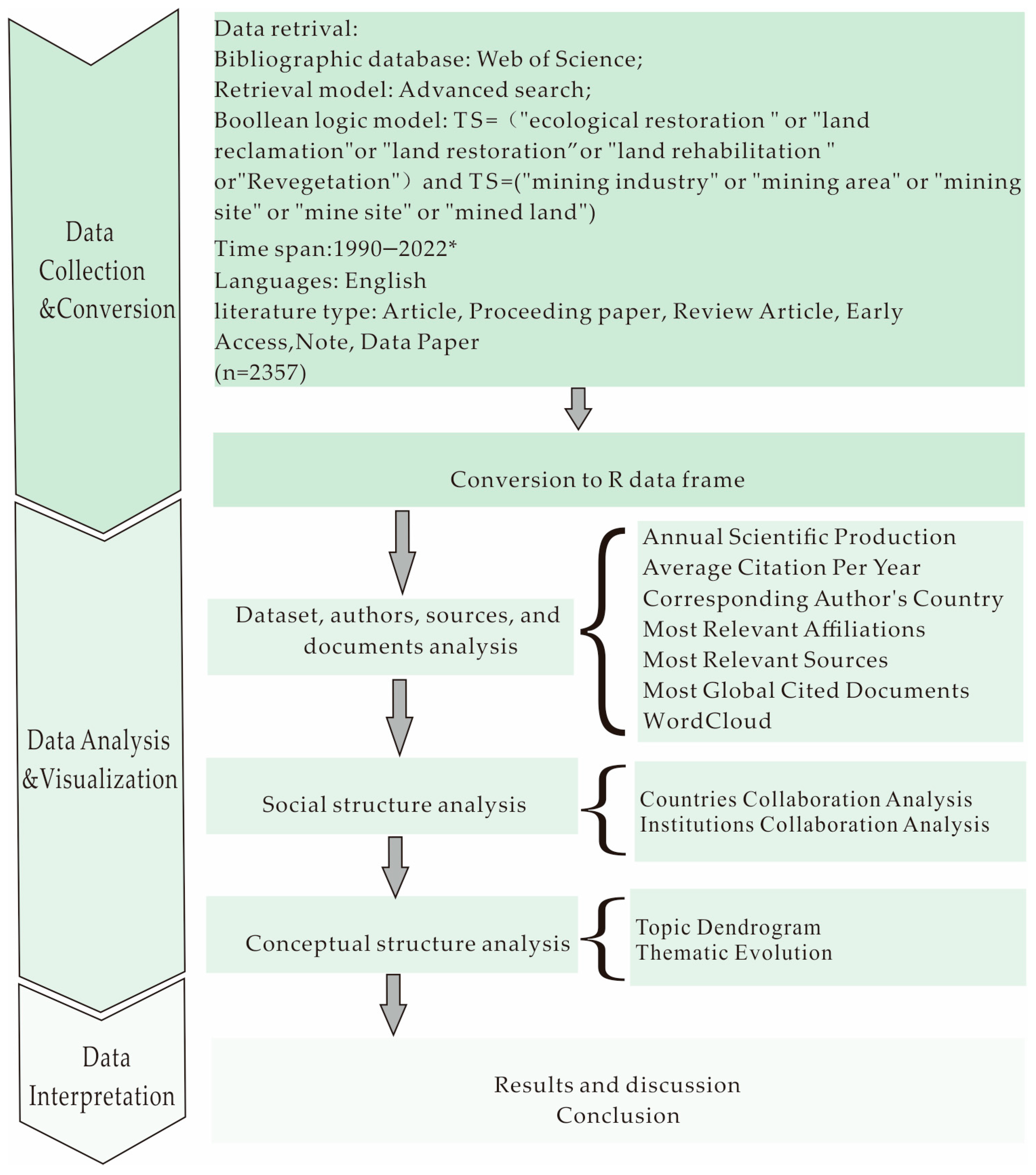
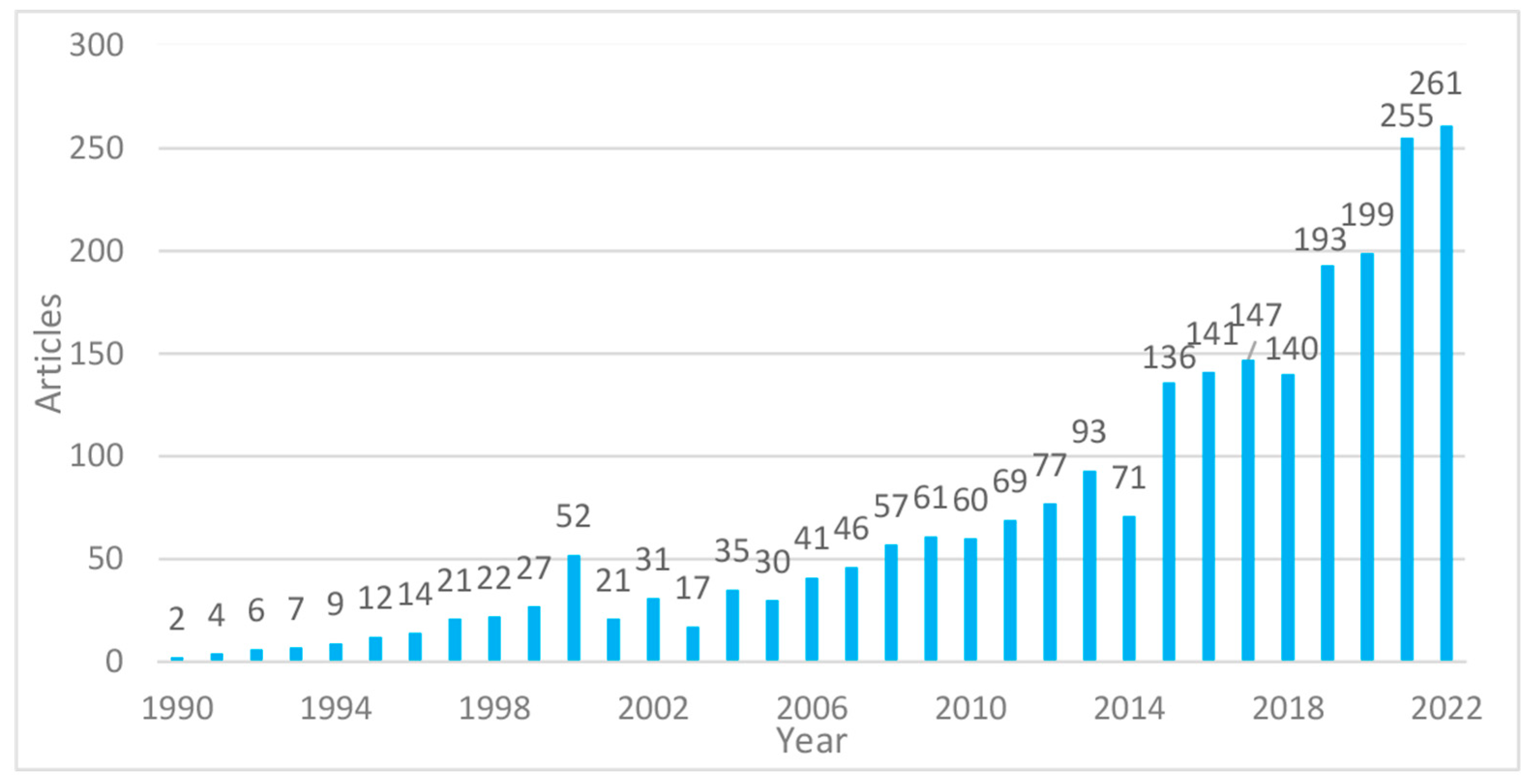
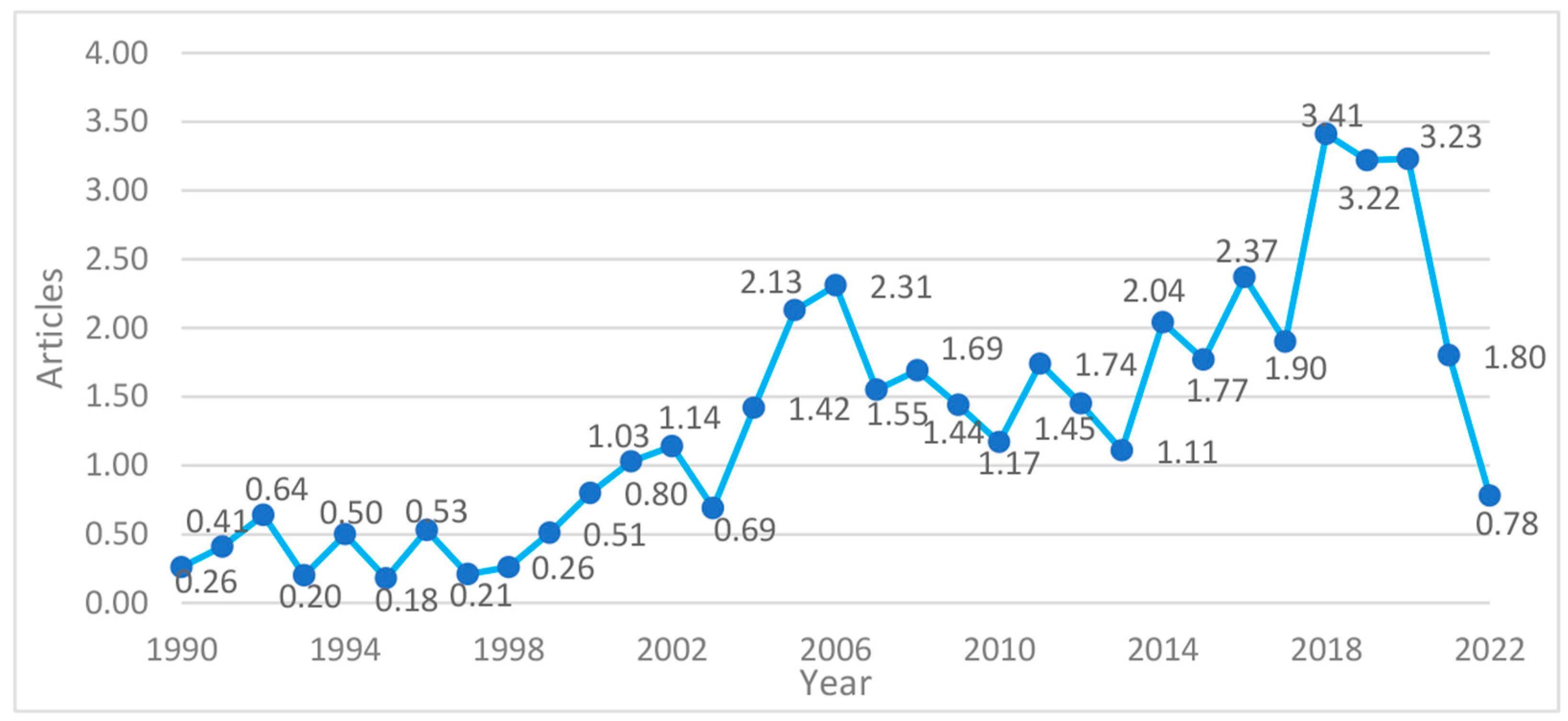

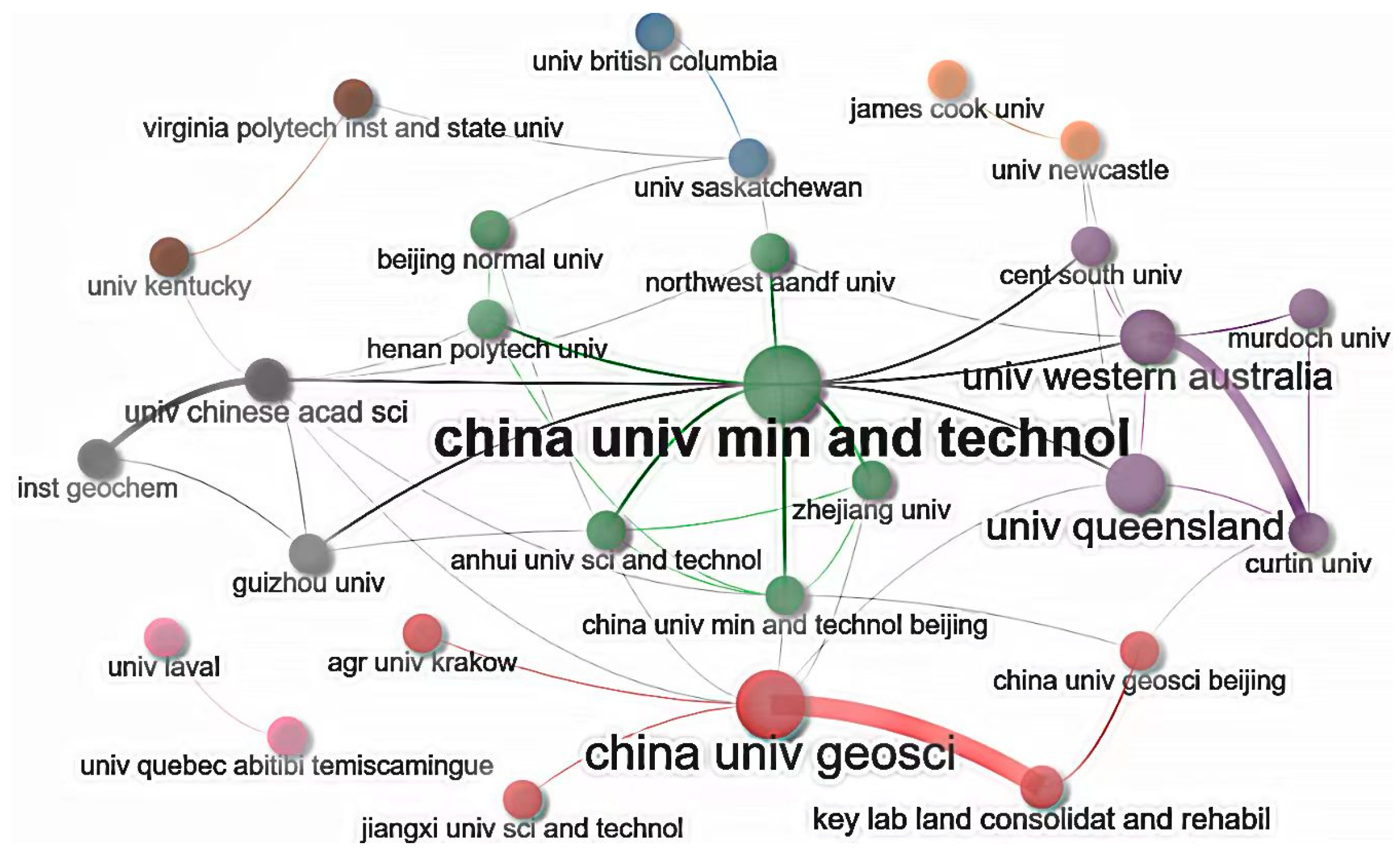
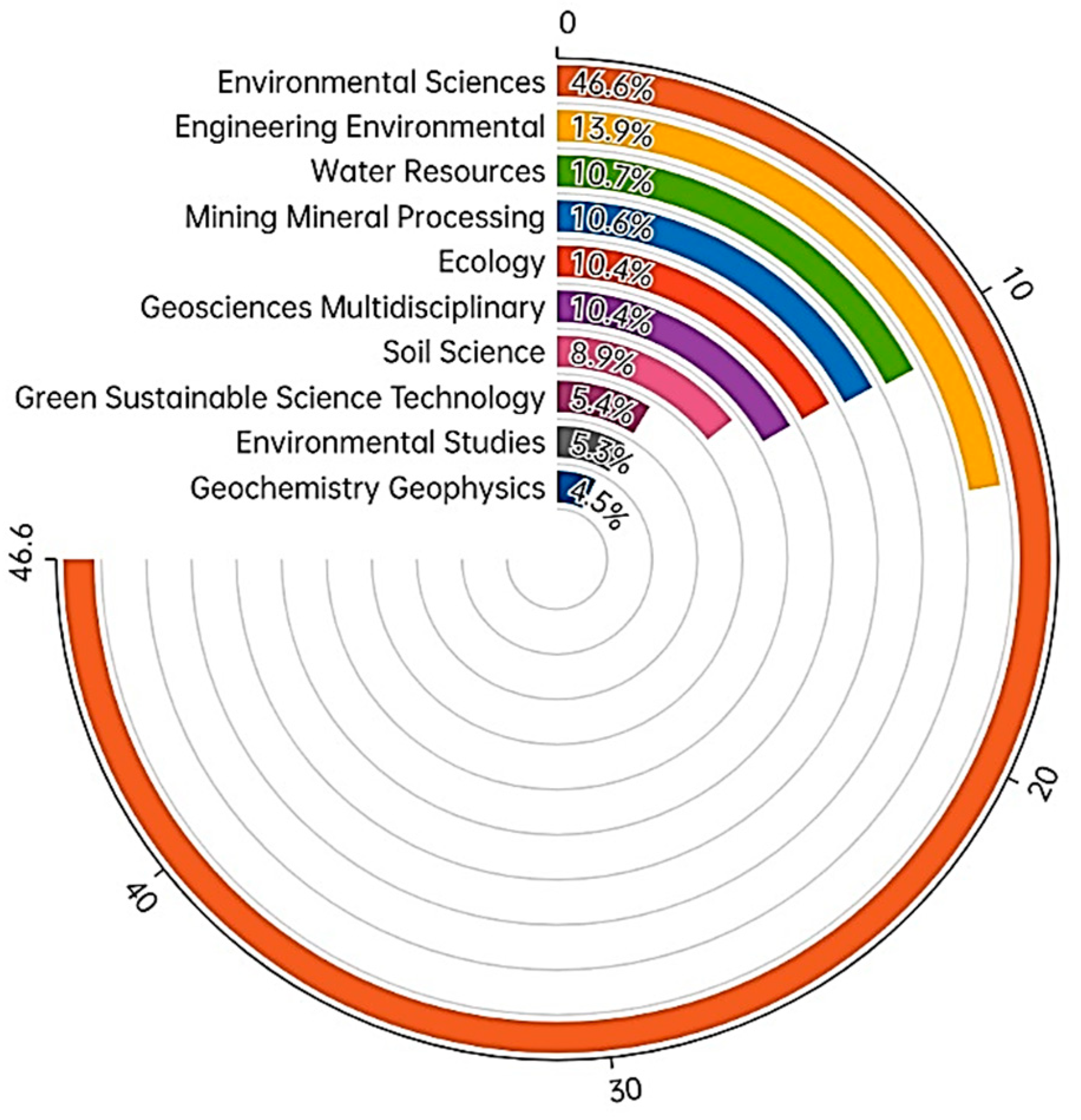

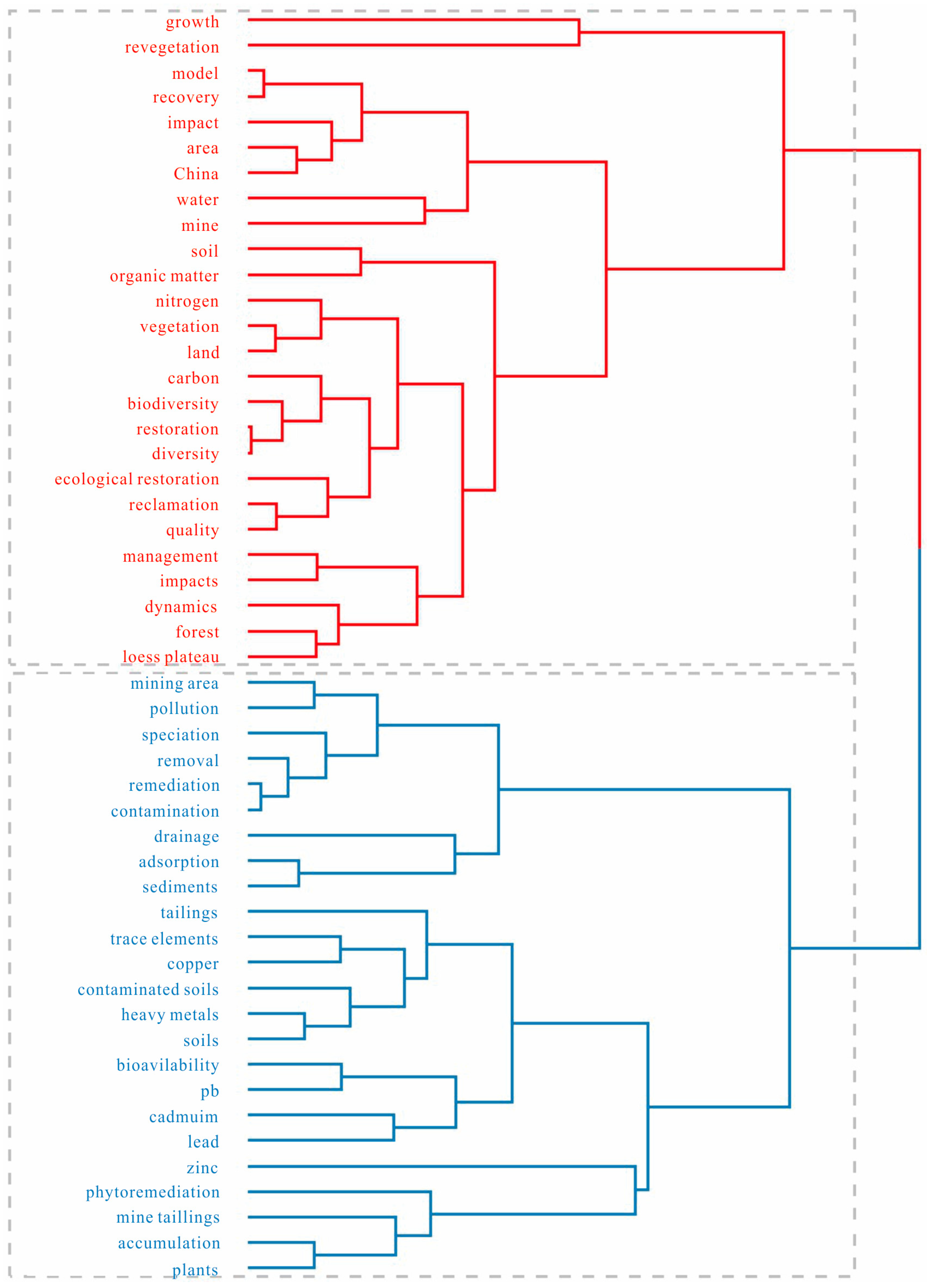

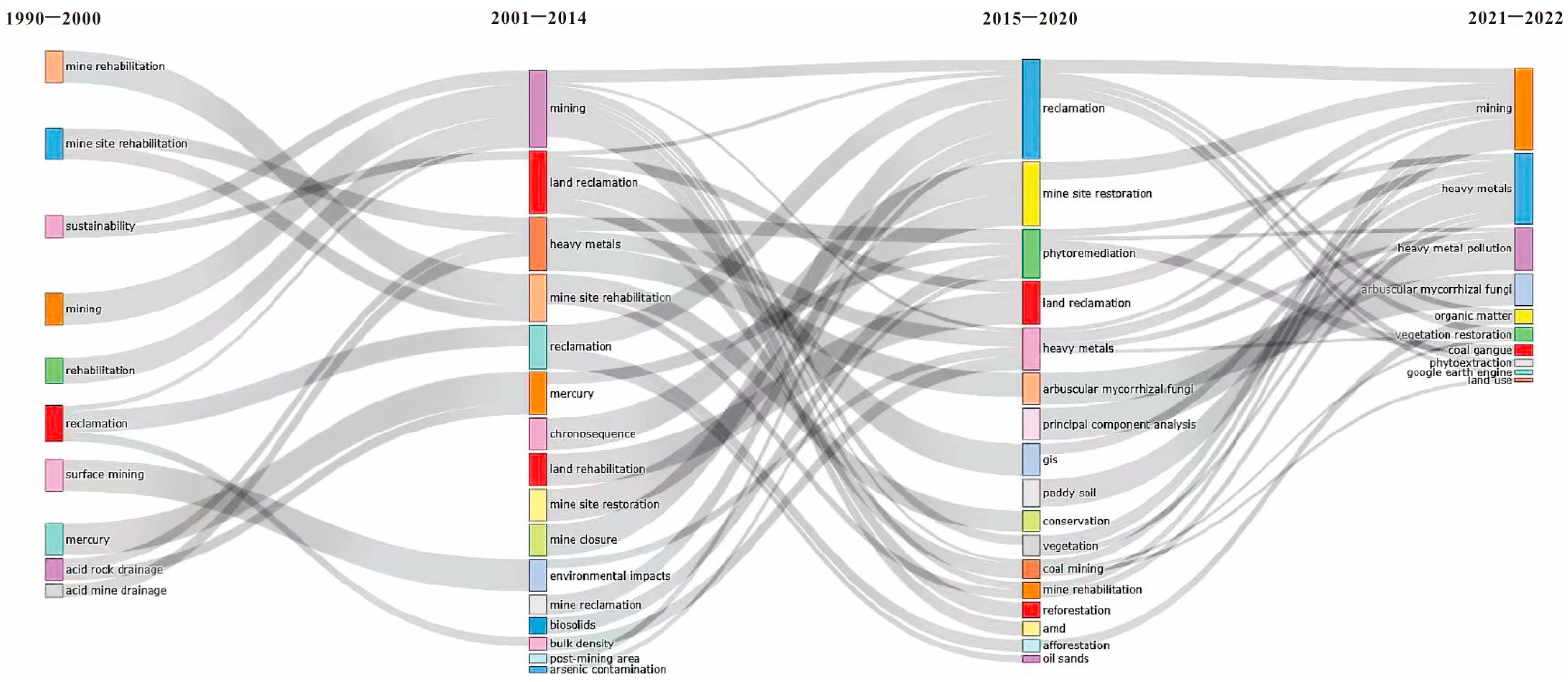
| Rank | Paper | DOI | Year | Journal | TC |
|---|---|---|---|---|---|
| 1 | SHEORAN AS, 2006, MINER ENG | 10.1016/j.mineng.2005.08.006 | 2006 | Minerals Engineering | 474 |
| 2 | LIU HY, 2005, SCI TOTAL ENVIRON | 10.1016/j.scitotenv.2004.07.030 | 2005 | Science of the Total Environment | 473 |
| 3 | RAZO I, 2004, WATER AIR SOIL POLL | 10.1023/B:WATE.0000015350.14520.c1 | 2004 | Water Air and Soil Pollution | 296 |
| 4 | LI MS, 2007, ENVIRON POLLUT | 10.1016/j.envpol.2006.08.006 | 2007 | Environmental Pollution | 264 |
| 5 | LI MS, 2006, SCI TOTAL ENVIRON | 10.1016/j.scitotenv.2005.05.003 | 2014 | Science of the Total Environment | 264 |
| 6 | YU HY, 2016, ENVIRON POLLUT | 10.1016/j.envpol.2015.11.021 | 2006 | Environmental Pollution | 197 |
| 7 | QIAO JT, 2018, CHEMOSPHERE | 10.1016/j.chemosphere.2017.12.081 | 2018 | Chemosphere | 192 |
| 8 | SHRESTHA RK, 2011, GEODERMA | 10.1016/j.geoderma.2010.12.015 | 2011 | Geoderma | 173 |
| 9 | RIOS CA, 2008, J HAZARD MATER | 10.1016/j.jhazmat.2007.11.123 | 2008 | Journal of Hazardous Materials | 170 |
| 10 | MACINTOSH DJ, 2002, ESTUAR COAST SHELF S | 10.1006/ecss.2001.0896 | 2002 | Estuarine Coastal and Shelf Science | 169 |
| Rank | Country | Number of Articles | Single-Country Publications (SCP) | Multiple-Country Publications (MCP) |
|---|---|---|---|---|
| 1 | China | 666 | 564 | 102 |
| 2 | Australia | 255 | 189 | 66 |
| 3 | USA | 227 | 204 | 23 |
| 4 | Canada | 143 | 118 | 25 |
| 5 | Germany | 83 | 68 | 15 |
| 6 | Poland | 75 | 69 | 6 |
| 7 | India | 73 | 66 | 7 |
| 8 | Spain | 69 | 50 | 19 |
| 9 | Brazil | 64 | 49 | 15 |
| 10 | UK | 50 | 38 | 12 |
| Rank | Research Institution | Country | Number of Articles |
|---|---|---|---|
| 1 | The China Univ Min and Technol | China | 133 |
| 2 | Univ Queensland | Australia | 98 |
| 3 | China Univ Geosci | China | 84 |
| 4 | Univ Western Australia | Australia | 70 |
| 5 | Curtin Univ | Australia | 46 |
| 6 | China Univ Min and Technol Beijing | China | 42 |
| 7 | Univ Chinese Acad Sci | China | 36 |
| 8 | Key Lab Land Consolidat and Rehabil | China | 33 |
| 9 | Univ Cagliari | Italy | 27 |
| 10 | Univ Quebec Abitibi Temiscamingue | Canada | 27 |
| Rank | Journal | Country | Journal Citation Report (JCR) | Impact Factor (If) | Articles |
|---|---|---|---|---|---|
| 1 | Science of the Total Environment | The Netherlands | Q1 | 10.753 | 74 |
| 2 | Environmental Science and Pollution Research | Germany | Q2 | 5.190 | 53 |
| 3 | Restoration Ecology | United States | Q2 | 4.181 | 51 |
| 4 | Ecological Engineering | The Netherlands | Q2 | 4.379 | 46 |
| 5 | Journal of Cleaner Production | United States | Q1 | 11.072 | 44 |
| 6 | Environmental Earth Sciences | Germany | Q2 | 3.119 | 41 |
| 7 | Journal of Environmental Management | England | Q1 | 8.910 | 41 |
| 8 | Sustainability | Switzerland | Q2 | 3.889 | 41 |
| 9 | Chemosphere | England | Q1 | 8.943 | 36 |
| 10 | Remote Sensing | Switzerland | Q1 | 5.349 | 29 |
Disclaimer/Publisher’s Note: The statements, opinions and data contained in all publications are solely those of the individual author(s) and contributor(s) and not of MDPI and/or the editor(s). MDPI and/or the editor(s) disclaim responsibility for any injury to people or property resulting from any ideas, methods, instructions or products referred to in the content. |
© 2023 by the authors. Licensee MDPI, Basel, Switzerland. This article is an open access article distributed under the terms and conditions of the Creative Commons Attribution (CC BY) license (https://creativecommons.org/licenses/by/4.0/).
Share and Cite
Shao, Y.; Xu, Q.; Wei, X. Progress of Mine Land Reclamation and Ecological Restoration Research Based on Bibliometric Analysis. Sustainability 2023, 15, 10458. https://doi.org/10.3390/su151310458
Shao Y, Xu Q, Wei X. Progress of Mine Land Reclamation and Ecological Restoration Research Based on Bibliometric Analysis. Sustainability. 2023; 15(13):10458. https://doi.org/10.3390/su151310458
Chicago/Turabian StyleShao, Ya, Qinxue Xu, and Xi Wei. 2023. "Progress of Mine Land Reclamation and Ecological Restoration Research Based on Bibliometric Analysis" Sustainability 15, no. 13: 10458. https://doi.org/10.3390/su151310458
APA StyleShao, Y., Xu, Q., & Wei, X. (2023). Progress of Mine Land Reclamation and Ecological Restoration Research Based on Bibliometric Analysis. Sustainability, 15(13), 10458. https://doi.org/10.3390/su151310458





